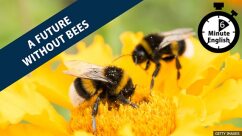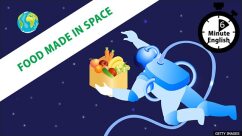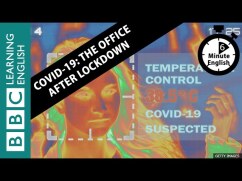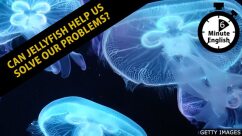food_made_in_space.pdf
food_made_in_space.mp3
6 Minute English
Food made in space
This is not a word-for-word transcript
Neil
Hello This is 6 Minute English from BBC Learning English I’m Neil
Georgina
And I’m Georgina
Neil
Last November Nasa launched a very unusual home delivery service – a rocket
carrying four tonnes of supplies to the ISS - the International Space Station
Georgina
Among the scientific equipment were twelve bottles of red wine from the famous
Bordeaux region of France
Neil
The astronauts might have wanted a glass of wine with dinner, but the real
purpose of the bottles was to explore the possibility of producing food and drink
in space – not for astronauts but for people back on Earth
Georgina
In today’s programme we’ll be finding out how growing plants in space can
develop crops which are more productive and more resistant to climate change
here on Earth
Neil
And we’ll hear how plants can grow in environments with little or no natural
light But first, today’s quiz question what was the first food grown in space?
Was it
a) potatoes
b) lettuce, or
c) tomatoes?
Georgina
Well, in the film, The Martian, a stranded astronaut grows potatoes on Mars I
know it’s only a film but I’ll say a) potatoes
Neil
OK We’ll find out the answer later Now, you might be wondering how it’s
possible to grow plants without natural light British company Vertical Future has
been working on this problem by developing indoor farming methods in
partnership with Nasa
Georgina
Here’s their Head of Research, Jen Bromley, explaining the process to BBC World
Service programme, The Food Chain
Jen Bromley
Basically we use LED lighting and we use LED lights that are tuned to a specific
wavelength So, if you image what the rainbow looks like, the reason a plant
looks green is because it’s not using all the green light – it actually reflects a lot
of that back So the reason why it looks pink in here is because we’re actually
only using red light and blue light to grow the plants, and that essentially tailors
the light diet so that the plants look black when you look at them because
they’re not reflecting any light– they’re being super-efficient, they’re using up
every photon that hits them
Neil
The lack of natural light in space means that plants are grown using LED lights –
LED is an abbreviation of ‘light emitting diode’ - an electronic device that lights
up when electricity is passed through it
Georgina
On Earth plants look green because they reflect back any light travelling at a
certain wavelength - the distance between two waves of light which make things
appear to us in the various colours of the rainbow
Neil
But when scientists control the wavelengths being fed, plants are able to absorb
every photon – particle of light energy, making them appear black
Georgina
Each particle of light that hits the leaves is absorbed and through photosynthesis
is converted into plant food Nasa found that different colour combinations, or
light recipes, can change a plants’ shape, size and even flavour
Neil
But the lack of natural light isn’t the biggest obstacle to growing food in space
Here’s Gioia Massa, chief plant scientist at the Kennedy Space Centre in Florida,
to explain
Gioia Massa
Microgravity is really challenging but plants are amazing They can adapt to so
many different environments – we call this plasticity because they can turn on or
off their genes to really adapt to all sorts of conditions and that’s why you see
plants growing in different areas on Earth - the same type of plant may look very
different because it’s adapting to the environment in that specific location
Georgina
On Earth, plants use gravity to position themselves – shoots grow up, roots grow
down But this doesn’t apply in space because of microgravity - the weaker pull
of gravity making things float and seem weightless
Neil
Plants can only survive in these conditions due to their plasticity – the ability of
living organisms to adapt and cope with changes in the environment by changing
their biological structure
Georgina
Plants adapt themselves to being in space by manipulating their genes -
chemicals and DNA in the cells of plants and animals which control their
development and behaviour
Neil
In the low-gravity atmosphere of space, plants become stressed but they adapt
genetically
Georgina
And as a result they’re stronger and more resilient to other, less stressful events
when they return home to Earth
Neil
Like those bottles of red wine orbiting Earth as we speak The effects of
microgravity on the wine’s organic composition will be studied and could
hopefully offer solutions for growing food in Earth’s changing climate
Georgina
So, Neil, if it wasn’t red grapes, what was the first food grown in space?
Neil
Ah yes, in today’s quiz question I asked what the first plant grown in space was
Georgina
I said, a) potatoes
Neil
But in fact it was… b) lettuce - grown over fifteen months on the ISS, then eaten
in fifteen minutes in the first ever space salad
Georgina
Today we’ve been discussing the possibilities of growing plants in space using
LED lights – devices that use electricity to produce light
Neil
The energy needed for plants to grow is contained in photons – or light particles,
travelling at different wavelengths – distances between light waves which make
things look different colours
Georgina
Plants have evolved over millennia using the strong gravity on Earth But this
changes in space because of microgravity – the weaker gravitational pull making
things in space float and seem weightless
Neil
Luckily plants use their genes – the chemicals in DNA responsible for growth - to
adapt to new environments by changing their biological structure – a process
known as plasticity
Georgina
All of which makes it possible for astronauts to enjoy a glass of wine and green
salad in space
Neil
And genetically stronger plants specimens to study back on Earth
Georgina
That’s all for today but join us again soon at 6 Minute English Bye for now
Neil
Bye
VOCABULARY
LED light
electronic device that lights up when electricity is passed through it -
abbreviation of ‘light emitting diode’
wavelength
the distance between two waves of light which makes things appear to us in the
different colours of the rainbow
photon
single unit of light
microgravity
weaker pull of gravity in space, making things float and seem weightless
plasticity
ability of a plant to adapt to and cope with changes in the environment by
changing its biological structure
genes
chemicals and DNA in the cells of plants and animals which control their
development and behaviour









